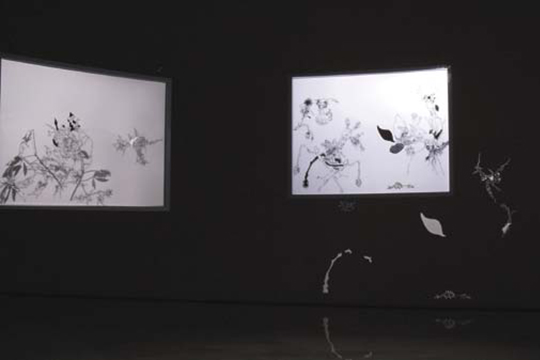THE 8TH INTERNATIONAL INK ART BIENNALE OF SHENZHEN: YOUNG INK
| March 11, 2014 | Post In 2014年2月号

2010-2013, Animation installation, 3 min. 15 sec.
The Shenzhen Ink Art Biennale may well have been the first biennial founded specifically to show a traditional art form. Thus, its influence has been limited to the fields of ink painting and traditional Chinese painting. The only exception has been the 2006 edition, “Ink, Life, Taste,” curated by German Sinologist Martina Köppel Yang, who initiated a shift from ink painting as art genre to ink painting as cultural medium. She included artists active in the Pearl River Delta such as the Yangjiang Group, Chu Yun, Jiang Zhi, and others. This experiment became a highlight of its day and was widely debated. Though worthy of further discussion, the concept was not taken forward into the next two biennials.
Considered against this background, we can see that this year’s rather ambitious exhibition, whether intentionally or otherwise, responds to the subject brought up years earlier. The co-curators this year are both also women: Chen Jun is an art historian, and Fu Xiaodong a traditional Chinese painter. Their themes for this year’s show, contemporary interpretations of “archetype” (trans. note: in English, the organizers refer to this as “prototype”) and “brush and ink,” are therefore not surprising. Compared to “brush and ink,” the Jungian “archetype” is a slightly more difficult concept, used most broadly in the humanities and image studies. An archetype is a primordial pattern that represents a typical human type, event, or idea. For the ordinary viewer, “brush and ink” requires specialist training to appreciate, but an image seems easier to grasp.
Apart from the first gallery, which explores landscape from a pictorial point of view, the other sections of the exhibition are in art historical terms closer to motifs (referred to as “motives”) than archetypes. These present contemporary artificial landscapes, images of women, religion, and fantastical landscapes. To some degree, they are not just simply formal categories; they also have cultural meaning in the history of the image. The curators are ambitious in reducing the classics to a series of archetypes, then considering these in a contemporary arts and humanities context. In this way, the biennial is about more than just ink art.
“Ink painting” takes on a variety of meanings in this show. It can be understood as a contemporary interpretation of the motif or archetype of ink painting. It could be a visual translation in the classical revival style of Wu Qiang. It could be the edited video images of Shen Ruiyun, or Duan Jianyu’s “Goddess Biographies,” or Jiang Zhi’s landscapes of bodies. When separated from brush and ink and viewed in the framework of archetypes, ink painting as a category becomes unclear and takes on the characteristics of something more like Wittgenstein’s family resemblance. Although not the works that conform to ink’s categorization have a medium in common, there is still some overlap in their ideas, concerns, form, and subject matter. It is this commonality that gives the all-encompassing exhibition an organic feel. More importantly, it is a brazen display
of linguistic progressiveness.
In contrast to Martina Köppel Yang, who tried to show that Chinese contemporary artists use subject matter to assert ink painting’s contemporary relevance, this exhibition expresses a clear point of view: if you enter the collective unconscious of artistic creation, you will discover that ink painting is part of the contemporary, and vice versa. This completely subverts the binary opposition between ink painting and the contemporary. If you experience the exhibition in person you will also find that the distinction between that which is ink painting and that which is not disappears; the relationship becomes intriguing, real, and organic. This biennial may come as a disappointment to those who wield New Ink as a counter to contemporary art. However, amidst the clamor of ink painting discourse at present, the completely anti-essentialist attitude of the exhibition is precisely what makes it so unique and provocative. Pi Li (Translated by Vanessa Nolan)

